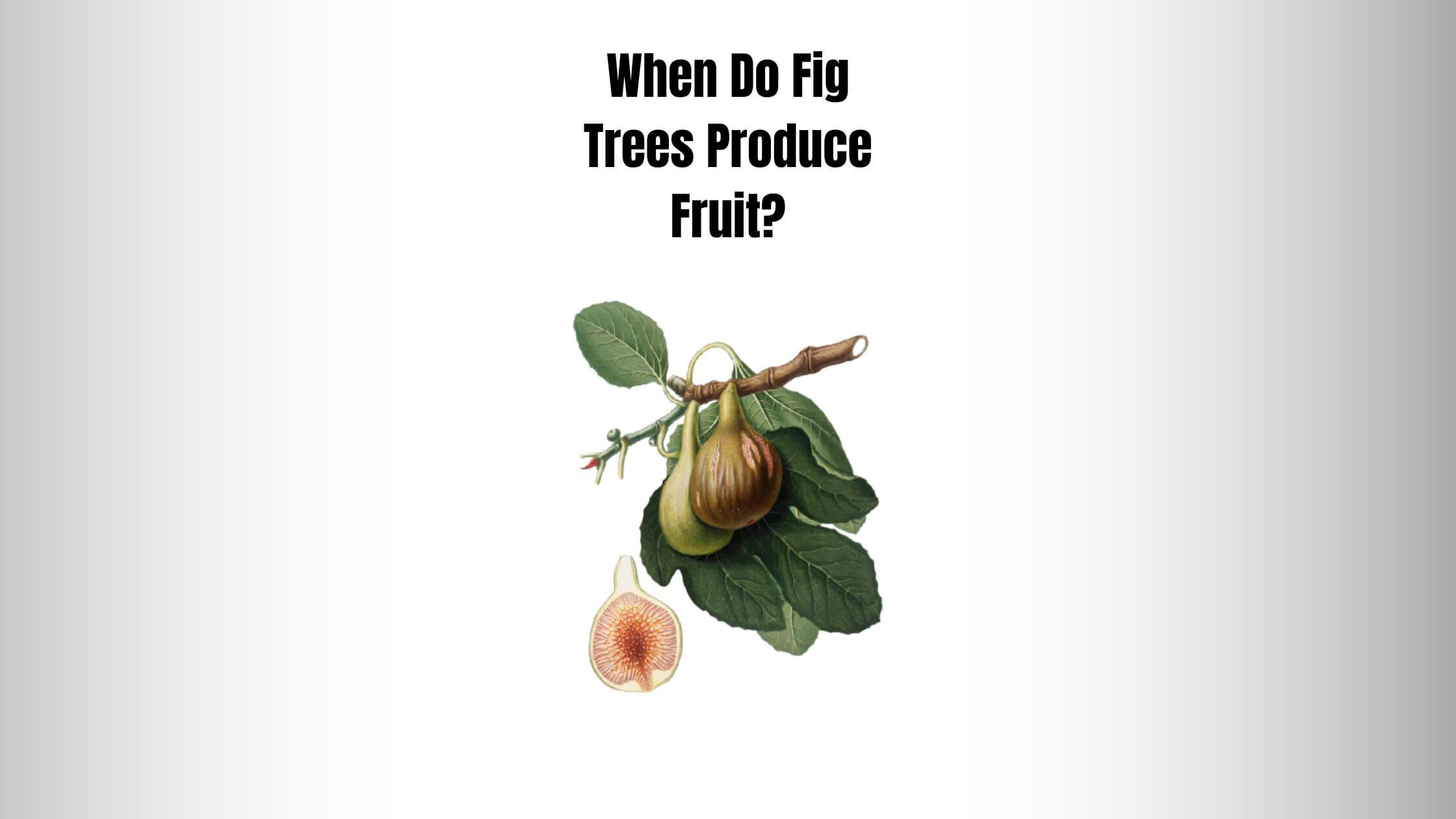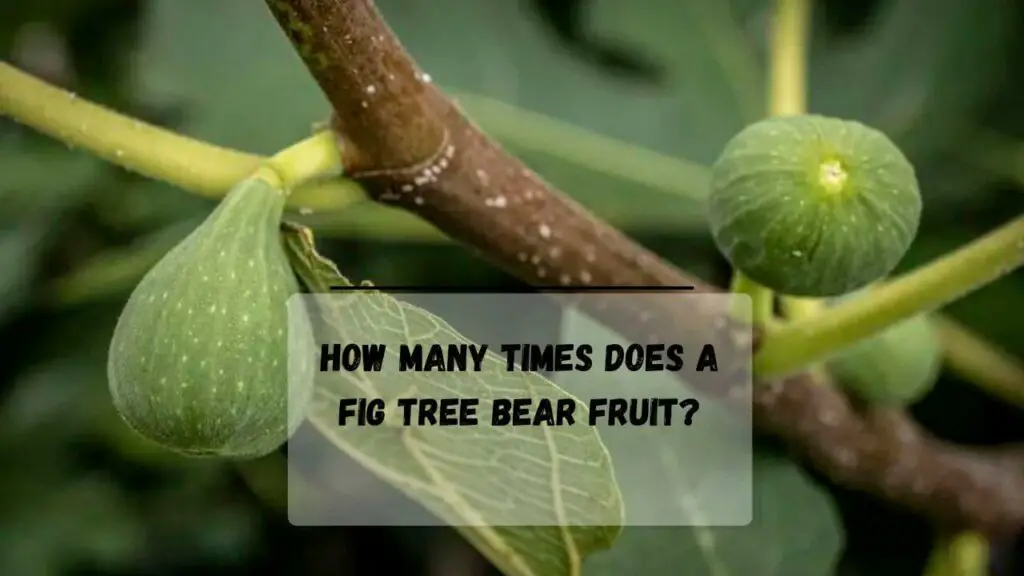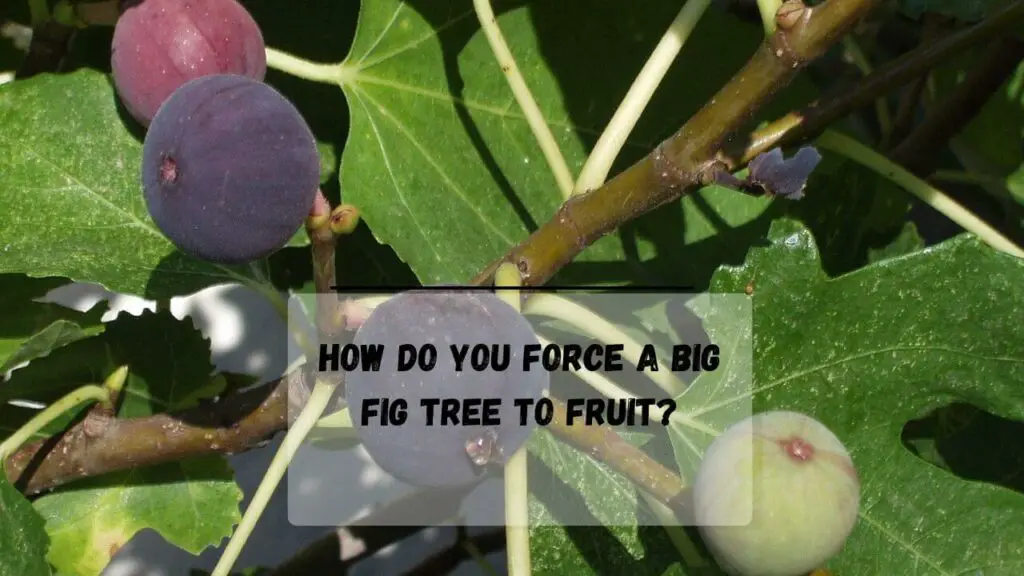
Fig trees are among the most popular ornamental pieces for beginners. Due to their low maintenance requirement and ability to produce fruit in hot and warm climates, they’re many people’s first choice.
In this article, we will learn ‘when do fig trees produce fruit’ and also understand the fruiting cycle for growing and harvesting this delicious fruit. Here, you will learn the best timing of fig tree fruit production and how many times a year the fig tree produces fruit.
I will share some interesting facts and tips that can encourage healthy fruiting if implemented correctly. Whether you are a homeowner or a gardener just starting, this formation will help you get the most out of your fig tree. Let’s first find out ‘when fig trees produce fruit.’
When Do Fig Trees Produce Fruit?
Surprisingly, fig trees have a fruit growth cycle with two different fruiting seasons depending on the condition and region. The first season fruit of the fig tree is popularly known as the ‘breba crop,’ which mainly occurs in the springtime, whereas the main crop is produced in the late summer or early fall, depending upon the climate and conditions.
The exact timing of a fig tree fruit production will vary depending on the cultivator, specific environment, and other factors. You can expect to see the figs fruiting in season during late summer or early fall.
How Many Times Does A Fig Tree Bear Fruit?

Fig trees produce and bear fruit multiple times a year with two different crops depending upon the region. The most common main crop usually occurs in the late summer, and the breba crop appears in the spring.
Some fig trees, mainly in tropical areas, may produce fruit more frequently than others throughout the year. Youactors to under multiple factors and the exact time a fig tree has fruit, including age, cultivar, environmental conditions, soil fertility, and many others.
If the fig tree is still young or yet to mature, it is likely to produce one crop a year only compared to the older. Thus, well-established fig trees will bear fruit two times or more depending upon specific conditions.
Do note that any bad weather like drought or Frost will affect the number of fruiting. Just remember that figs can be unpredictable when it comes to knowing about their right timing of fruiting.
Even with the best care, some fig trees may not be able to produce fruit every year. It is essential to understand your fig tree fruiting pattern and the factors that might affect it to increase the chances of successfully growing this delicious fruit. Here is why fig trees are not fruiting.
Why Do My fig Trees Not Producing Fruits?
There can be many reasons your fig tree does not produce enough fruit, depending on a few factors. Below I am giving you a few reasons to understand the issue better & address it as soon as possible to encourage the fig tree to produce more fruit sooner.
Environmental Factor.
Maybe your fig tree is not getting the proper temperature, right humidity level, and lighting needed to produce fruit. If your fig tree is placed in a region with almost little to no sunlight during the daytime, it will hinder its fruiting growth.
Therefore I recommend you care for your fig tree by providing lots of water, sunlight, and nutrients needed to produce better fruits. Also, keep a fig tree in a warm, humid temperature to keep it growing.
Owner Mistake.
You might have overinvested in the fig tree’s soil, or the ground is not well drained. Fig tree needs well-drained soil and frequent watering. It is essential to water the fig tree’s soil from time to time from its base if it starts to look crumbly and dry.
In addition, you should also practice the proper pruning technique using safe tools. Pruning the fig tree incorrectly will hinder its growth and fruit production.
Age.
Like any other trees, fig-trees also take many years to reach full maturity and produce fruit at their best. If your fig tree is yet to mature, give it some time and attention to its environment. It might be a matter of time before your fig tree starts fruiting.
Pollination.
If your fig tree is not getting enough pollination to produce maximum fruiting, try planting flowering plants that attract pollinators like butterflies, bees, and more. Sometimes bad weather conditions also keep the fig tree from having infinite fruits.
Pest Infestation Or Disease.
Like any other plant, a fig tree is also prone to pest infestation and diseases if not cleared properly. They are prone to pest infestations like spider mites which feed on their branches. If your fig tree also suffers from any underlying diseases, it will also affect its fruit production.
What Should You Do?
- Firstly, I recommend you regularly provide well-draining soil with the correct amount of sunlight, water, and nutrients.
- Other than these, perform regular pruning to promote healthy growth and fruiting.
- Sometimes, environmental factors affect the fig tree growth and fruiting. So make changes to the growing condition as necessary to address the issue.
- Don’t think growing a flower bed will attract pollinators and promote fruit growth. Choosing the right plants that come with long stems to attract pollinators on a high amount is essential.
- Also, check for signs of diseases and pest infestation to address the issue as soon as found & prevent any further damage.
Understanding the exact cause of why a fig tree may not produce fruit will keep you ahead in taking the proper steps to address them and encourage the fig tree to produce more fruit. Remember that good care and maintenance are critical to successful fruiting. You can try the method I’ve given to force a fig to fruit if you want.
How Do You Force A Big Fig Tree To Fruit?

You can try many methods to encourage fruit production in a fig tree. But, using the correct way and following a systematic approach will help you promote fruiting at its best. Before I tell you the plans for forcing a fig tree to fruit, you should pay attention to the proper care and maintenance as it is essential for its overall health and productivity.
Fig trees are among the most popular ornamental pieces for beginners. Due to their low maintenance requirement and ability to produce fruit in hot and warm climates, they’re many people’s first choice.
In this article, we will learn ‘when fig trees produce fruit’ and also understand the fruiting cycle for growing and harvesting this delicious fruit. Here, you will learn the best timing of fig tree fruit production and how many times a year the fig tree produces fruit.
I will share some interesting facts and tips that can encourage healthy fruiting if implemented correctly. Whether you are a homeowner or a gardener just starting, this formation will help you get the most out of your fig tree. Let’s first find out ‘when fig trees produce fruit.’
When Do Fig Trees Produce Fruit?
Surprisingly, fig trees have a fruit growth cycle with two different fruiting seasons depending on the condition and region. The first season fruit of the fig tree is popularly known as the ‘breba crop,’ which mainly occurs in the springtime, whereas the main crop is produced in the late summer or early fall, depending upon the climate and conditions.
The exact timing of a fig tree fruit production will vary depending on the cultivator, specific environment, and other factors. You can expect to see the figs fruiting in season during late summer or early fall.
How Many Times Does A Fig Tree Bear Fruit?
Fig trees produce and bear fruit multiple times a year with two different crops depending upon the region. The most common main crop usually occurs in the late summer, and the breba crop appears in the spring.
Some fig trees, mainly in tropical areas, may produce fruit more frequently than others throughout the year. Youactors to under multiple factors and the exact time a fig tree has fruit, including age, cultivar, environmental conditions, soil fertility, and many others.
If the fig tree is still young or yet to mature, it is likely to produce one crop a year only compared to the older. Thus, well-established fig trees will bear fruit two times or more depending upon specific conditions.
Do note that any bad weather like drought or Frost will affect the number of fruiting. Just remember that figs can be unpredictable when it comes to knowing about their right timing of fruiting.
Even with the best care, some fig trees may not be able to produce fruit every year. It is essential to understand your fig tree fruiting pattern and the factors that might affect it to increase the chances of successfully growing this delicious fruit. Here is why fig trees are not fruiting.
Why Do My fig Trees Not Producing Fruits?
There can be many reasons your fig tree does not produce enough fruit, depending on a few factors. Below I am giving you a few reasons to understand the issue better & address it as soon as possible to encourage the fig tree to produce more fruit sooner.
Environmental Factor.
Your fig tree may not get the proper temperature, right humidity level, and lighting needed to produce fruit. If your fig tree is placed in a region with almost no sunlight during the daytime, it will hinder its fruiting growth.
Therefore I recommend you care for your fig tree by providing lots of water, sunlight, and nutrients needed to produce better fruits. Also, keep a fig tree in a warm, humid temperature to keep it growing.
Owner Mistake.
You might have overinvested in the fig tree’s soil, or the ground needs to be well drained. Fig tree needs well-drained soil and frequent watering. It is essential to water the fig tree’s soil from time to time from its base if it starts to look crumbly and dry.
In addition, you should also practice the proper pruning technique using safe tools. Pruning the fig tree correctly will help its growth and fruit production.
Age.
Like any other trees, fig-trees also take many years to reach full maturity and produce fruit at their best. If your fig tree is yet to mature, give it some time and attention to its environment. It might be a matter of time before your fig tree starts fruiting.
Pollination.
If your fig tree needs more pollination to produce maximum fruiting, try planting flowering plants that attract pollinators like butterflies, bees, and more. Sometimes bad weather conditions also keep the fig tree from having infinite fruits.
Pest Infestation Or Disease.
Like any other plant, a fig tree is also prone to pest infestation and diseases if not cleared properly. They are prone to pest infestations like spider mites which feed on their branches. If your fig tree also suffers from underlying conditions, it will affect fruit production.
What Should You Do?
- Firstly, please regularly provide well-draining soil with the correct amount of sunlight, water, and nutrients.
- Other than these, perform regular pruning to promote healthy growth and fruiting.
- Sometimes, environmental factors affect the fig tree growth and fruiting. So make changes to the growing condition as necessary to address the issue.
- Don’t think growing a flower bed will attract pollinators and promote fruit growth. Choosing the right plants that come with long stems to attract pollinators on a high amount is essential.
- Also, check for signs of diseases and pest infestation to address the issue as soon as found & prevent any further damage.
Understanding the exact cause of why a fig tree may not produce fruit will keep you ahead in taking the proper steps to address them and encourage the fig tree to produce more fruit. Remember that good care and maintenance are critical to successful fruiting. You can try the method I’ve given to force a fig to fruit if you want.
How Do You Force A Big Fig Tree To Fruit?
You can try many methods to encourage fruit production in a fig tree. But, using the correct way and following a systematic approach will help you promote fruiting at its best. Before I tell you the plans for forcing a fig tree to fruit, you should pay attention to the proper care and maintenance as it is essential for its overall health and productivity.
One of the most common and efficient ways to force a fig treat to produce fruit is by hand pollination. You need to collect the stamens of the male flower using a small brush and then transfer it to the female flower pistils on the same or a different fig tree.
Even though this process is time-consuming, you will have higher chances of successful fruiting. You can also stress your fig tree by reducing the water or cutting back its leaves to encourage fruit production.
There might be more effective ways, but it helps promote fruit growth. Make sure not to put excessive stress to harm the fig tree and reduce its overall productivity and health. In addition to this, make sure to continue pruning old leaves, branches, and stems to promote healthy growth and fruiting sooner.
Pruning will help the tree focus on fruiting rather than trying to revive its damaged parts. Lastly, make sure to provide a certain amount of light it needs to produce fruits.
By managing the proper amount of light your tree receives, you will successfully encourage it to grow and fruit. It would be best to consider removing nearby fig trees and other obstacles blocking the sunlight.
Conclusion
Since fig trees are trendy and an essential part of the culture, it can be very concerning for the owners if they find out that the fig tree is not fruiting. Therefore understanding ‘why do fig trees, not fruit’ will help you fix the problem and increase the chances of successful fruiting.
As I told you, a fig tree typically produces fruit in the early fall or late summer. But exact timing usually varies depending upon climate, variety, and region. Most young trees fruit once a year compared to the older, fully mature tree that fruit twice a year.
And also, the number of fruits can significantly be affected by many factors like temperature, light, watering, and rainfall. If your fig tree is not producing fruit, check for signs of something wrong.
It is essential to check for pest diseases, lack of pollination, or improper care that might affect the fruit growth in fig trees. Some standard solutions to increase and force your tree to produce fruit are providing optimal care like pruning, fertilization, and pest management.
All in all, understanding when fig trees have fruit and the factor that may affect its number of fruit is a key to being a successful gardener.
Always remember that proper care and attention will result in a fig tree producing a bountiful crop each year. If you find this helpful, then do share. Check our other post on arboriculture and fig trees. See you in the next post. Till then,
take care and goodbye.
Conclusion
Since fig trees are trendy and an essential part of the culture, it can be very concerning for the owners if they find out that the fig tree is not fruiting. Therefore understanding ‘why my fig trees not fruiting’ will help you fix the problem and increase the chances of successful fruiting.
As I told you, a fig tree typically produces fruit in the early fall or late summer. But exact timing usually varies depending upon climate, variety, and region. Most young trees fruit once a year compared to the older, fully mature tree that fruit twice a year.
And also, the number of fruits can significantly be affected by many factors like temperature, light, watering, and rainfall. If your fig tree is not producing fruit, check for signs of something wrong.
It is essential to check for pest diseases, lack of pollination, or improper care that might affect the fruit growth in fig trees. Some standard solutions to increase and force your tree to produce fruit are providing optimal care like pruning, fertilization, and pest management.
All in all, understanding when fig trees have fruit and the factor that may affect its number of fruit is a key to being a successful gardener.
Always remember that proper care and attention will result in a fig tree producing a bountiful crop each year. If you find this helpful, then do share. Check our other post on arboriculture and fig trees. See you in the next post. Till then,
